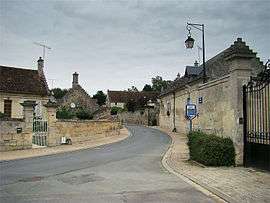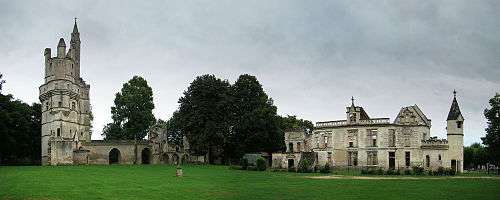Septmonts
| Septmonts | |
|---|---|
 | |
 Septmonts | |
|
Location within Hauts-de-France region  Septmonts | |
| Coordinates: 49°20′04″N 3°21′28″E / 49.3344°N 3.3578°ECoordinates: 49°20′04″N 3°21′28″E / 49.3344°N 3.3578°E | |
| Country | France |
| Region | Hauts-de-France |
| Department | Aisne |
| Arrondissement | Soissons |
| Canton | Soissons-Sud |
| Intercommunality | Soissonnais |
| Government | |
| • Mayor (2008–2014) | Michael Douay |
| Area1 | 4.8 km2 (1.9 sq mi) |
| Population (2008)2 | 561 |
| • Density | 120/km2 (300/sq mi) |
| Time zone | CET (UTC+1) |
| • Summer (DST) | CEST (UTC+2) |
| INSEE/Postal code | 02706 / 02200 |
| Elevation |
57–161 m (187–528 ft) (avg. 75 m or 246 ft) |
|
1 French Land Register data, which excludes lakes, ponds, glaciers > 1 km² (0.386 sq mi or 247 acres) and river estuaries. 2 Population without double counting: residents of multiple communes (e.g., students and military personnel) only counted once. | |
Septmonts is a commune in the Aisne department in Hauts-de-France in northern France.
Population
| Historical population | ||
|---|---|---|
| Year | Pop. | ±% |
| 1793 | 324 | — |
| 1800 | 408 | +25.9% |
| 1806 | 286 | −29.9% |
| 1821 | 361 | +26.2% |
| 1831 | 428 | +18.6% |
| 1836 | 438 | +2.3% |
| 1841 | 452 | +3.2% |
| 1846 | 450 | −0.4% |
| 1851 | 442 | −1.8% |
| 1856 | 427 | −3.4% |
| 1861 | 474 | +11.0% |
| 1866 | 458 | −3.4% |
| 1872 | 445 | −2.8% |
| 1876 | 463 | +4.0% |
| 1881 | 464 | +0.2% |
| 1886 | 437 | −5.8% |
| 1891 | 447 | +2.3% |
| 1896 | 440 | −1.6% |
| 1901 | 432 | −1.8% |
| 1906 | 458 | +6.0% |
| 1911 | 412 | −10.0% |
| 1921 | 376 | −8.7% |
| 1926 | 425 | +13.0% |
| 1931 | 432 | +1.6% |
| 1936 | 439 | +1.6% |
| 1946 | 441 | +0.5% |
| 1954 | 446 | +1.1% |
| 1962 | 496 | +11.2% |
| 1968 | 532 | +7.3% |
| 1975 | 542 | +1.9% |
| 1982 | 516 | −4.8% |
| 1990 | 515 | −0.2% |
| 1999 | 501 | −2.7% |
| 2008 | 561 | +12.0% |
Donjon de Septmonts
In the heart of the village lies the remains of the Château de Septmonts, of which the principal remains are of the 14th century donjon or keep. The castle was the country seat of the Bishop of Soissons, probably since the last half of the 12th century and was first built in stone a little before 1242.
Thought to have been inspired by the works of Charles V of France, the 43 metre tall donjon, exemplifies the princely style of the late 14th century, combining both military and residential function.
The donjon is currently undergoing a programme of restoration. The other sights at the chateau include:
- Ditches and walls
- Remains of the Salle St. Louis (13th century hall)
- Remains of the Renaissance bishop's palace
- Verger and Arboretum de Septmonts
Saint-André de Septmonts church
The village contains a fifteenth-century church in the flamboyant style.
See also
References
- Mesqui, Jean (1997). Chateaux-forts et fortifications en France. Paris: Flammarion. ISBN 2-08-012271-1.

| Wikimedia Commons has media related to Septmonts. |